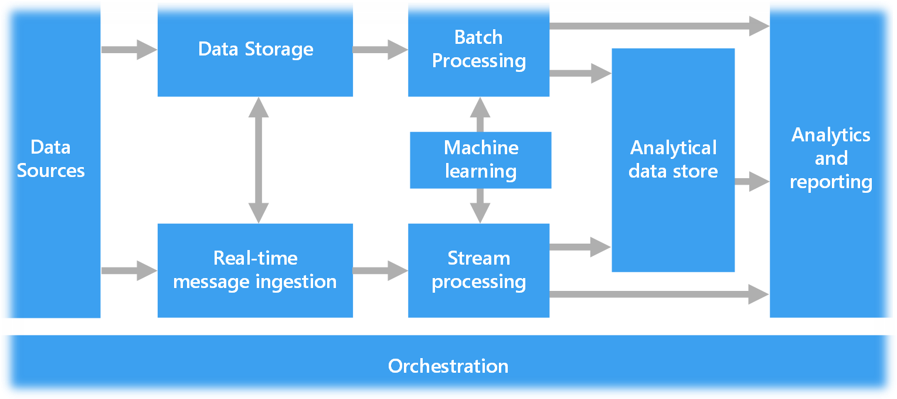
Components of a big data architecture

A big data architecture is designed to handle the ingestion, processing, and analysis of data that is too large or complex for traditional database systems. The threshold at which organizations enter into the big data realm differs, depending on the capabilities of the users and their tools. For some, it can mean hundreds of gigabytes of data, while for others it means hundreds of terabytes. As tools for working with big datasets advance, so does the meaning of big data.
Big data solutions typically involve one or more of the following types of workloads:
- Batch processing of big data sources at rest.
- Real-time processing of big data in motion.
- Interactive exploration of big data.
- Predictive analytics and machine learning.
Consider big data architectures when you need to:
- Store and process data in volumes too large for a traditional database.
- Transform unstructured data for analysis and reporting.
- Capture, process, and analyze unbounded streams of data in real time, or with low latency.
Components of a big data architecture
Most big data architectures include some or all of the following components.
Data sources. All big data solutions start with one or more data sources. Examples include:
- Application data stores, such as relational databases.
- Static files produced by applications, such as web server log files.
- Real-time data sources, such as IoT devices.
Data storage. Data for batch processing operations is typically stored in a distributed file store that can hold high volumes of large files in various formats. This kind of store is often called a data lake. Options for implementing this storage include Azure Data Lake Store or blob containers in Azure Storage.
Batch processing. Because the data sets are so large, often a big data solution must process data files using long-running batch jobs to filter, aggregate, and otherwise prepare the data for analysis. Usually, these jobs involve reading source files, processing them, and writing the output to new files. Options include running U-SQL jobs in Azure Data Lake Analytics, using Hive, Pig, or custom Map/Reduce jobs in an HDInsight Hadoop cluster, or using Java, Scala, or Python programs in an HDInsight Spark cluster.
Real-time message ingestion. If the solution includes real-time sources, the architecture must include a way to capture and store real-time messages for stream processing. This might be a simple data store, where incoming messages are dropped into a folder for processing. However, many solutions need a message ingestion store to act as a buffer for messages, and to support scale-out processing, reliable delivery, and other message queuing semantics.
Stream processing. After capturing real-time messages, the solution must process them by filtering, aggregating, and otherwise preparing the data for analysis. The processed stream data is then written to an output sink. Azure Stream Analytics provides a managed stream processing service based on perpetually running SQL queries that operate on unbounded streams. You can also use open source. Apache streaming technologies like Spark Streaming in an HDInsight cluster.
Machine learning. Reading the prepared data for analysis (from batch or stream processing), machine learning algorithms can be used to build models that can predict outcomes or classify data. These models can be trained on large datasets, and the resulting models can be used to analyze new data and make predictions. This can be done using Azure Machine Learning
Analytical data store. Many big data solutions prepare data for analysis and then serve the processed data in a structured format that can be queried using analytical tools. The analytical data store used to serve these queries can be a Kimball-style relational data warehouse, as seen in most traditional business intelligence (BI) solutions.
Analysis and reporting. The goal of most big data solutions is to provide insights into the data through analysis and reporting. To empower users to analyze the data, the architecture may include a data modeling layer, such as a multidimensional OLAP cube or tabular data model in Azure Analysis Services. It might also support self-service BI, using the modeling and visualization technologies in Microsoft Power BI or Microsoft Excel.
Lambda architecture
- The lambda architecture is a hybrid approach that combines batch processing and real-time stream processing to provide both historical and up-to-the-moment insights. It uses batch layers, serving layers, and speed layers to process and aggregate data from various sources.
- When working with very large data sets, it can take a long time to run the sort of queries that clients need. These queries can't be performed in real time, and often require algorithms such as MapReduce that operate in parallel across the entire data set. The results are then stored separately from the raw data and used for querying.
The lambda architecture, first proposed by Nathan Marz, addresses this problem by creating two paths for data flow. All data coming into the system goes through these two paths:
- A batch layer (cold path) stores all of the incoming data in its raw form and performs batch processing on the data. The result of this processing is stored as a batch view.
- A speed layer (hot path) analyzes data in real time. This layer is designed for low latency, at the expense of accuracy.
The batch layer feeds into a serving layer that indexes the batch view for efficient querying. The speed layer updates the serving layer with incremental updates based on the most recent data.
Data that flows into the hot path is constrained by latency requirements imposed by the speed layer, so that it can be processed as quickly as possible. Often, this requires a tradeoff of some level of accuracy in favor of data that is ready as quickly as possible. For example, consider an IoT scenario where a large number of temperature sensors are sending telemetry data. The speed layer may be used to process a sliding time window of the incoming data.
Data flowing into the cold path, on the other hand, is not subject to the same low latency requirements. This allows for high accuracy computation across large data sets, which can be very time intensive.
Kappa architecture
Similar to the lambda architecture, the kappa architecture focuses solely on real-time processing. It uses stream processing technologies to process and analyze data in real time, eliminating the need for separate batch and speed layers.
- A drawback to the lambda architecture is its complexity. Processing logic appears in two different places — the cold and hot paths — using different frameworks. This leads to duplicate computation logic and the complexity of managing the architecture for both paths.
- The kappa architecture was proposed by Jay Kreps as an alternative to the lambda architecture. It has the same basic goals as the lambda architecture, but with an important distinction: All data flows through a single path, using a stream processing system.
There are some similarities to the lambda architecture's batch layer, in that the event data is immutable and all of it is collected, instead of a subset. The data is ingested as a stream of events into a distributed and fault tolerant unified log. These events are ordered, and the current state of an event is changed only by a new event being appended. Similar to a lambda architecture's speed layer, all event processing is performed on the input stream and persisted as a real-time view.